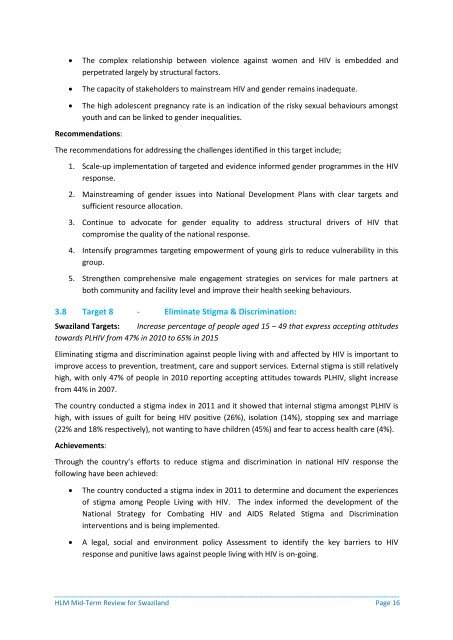Swaziland FINAL_HLM_MTR Stock-Taking Final Report 2013.pdf
Swaziland FINAL_HLM_MTR Stock-Taking Final Report 2013.pdf
Swaziland FINAL_HLM_MTR Stock-Taking Final Report 2013.pdf
- No tags were found...
You also want an ePaper? Increase the reach of your titles
YUMPU automatically turns print PDFs into web optimized ePapers that Google loves.
The complex relationship between violence against women and HIV is embedded andperpetrated largely by structural factors.The capacity of stakeholders to mainstream HIV and gender remains inadequate.The high adolescent pregnancy rate is an indication of the risky sexual behaviours amongstyouth and can be linked to gender inequalities.Recommendations:The recommendations for addressing the challenges identified in this target include;1. Scale-up implementation of targeted and evidence informed gender programmes in the HIVresponse.2. Mainstreaming of gender issues into National Development Plans with clear targets andsufficient resource allocation.3. Continue to advocate for gender equality to address structural drivers of HIV thatcompromise the quality of the national response.4. Intensify programmes targeting empowerment of young girls to reduce vulnerability in thisgroup.5. Strengthen comprehensive male engagement strategies on services for male partners atboth community and facility level and improve their health seeking behaviours.3.8 Target 8 - Eliminate Stigma & Discrimination:<strong>Swaziland</strong> Targets: Increase percentage of people aged 15 – 49 that express accepting attitudestowards PLHIV from 47% in 2010 to 65% in 2015Eliminating stigma and discrimination against people living with and affected by HIV is important toimprove access to prevention, treatment, care and support services. External stigma is still relativelyhigh, with only 47% of people in 2010 reporting accepting attitudes towards PLHIV, slight increasefrom 44% in 2007.The country conducted a stigma index in 2011 and it showed that internal stigma amongst PLHIV ishigh, with issues of guilt for being HIV positive (26%), isolation (14%), stopping sex and marriage(22% and 18% respectively), not wanting to have children (45%) and fear to access health care (4%).Achievements:Through the country’s efforts to reduce stigma and discrimination in national HIV response thefollowing have been achieved:The country conducted a stigma index in 2011 to determine and document the experiencesof stigma among People Living with HIV. The index informed the development of theNational Strategy for Combating HIV and AIDS Related Stigma and Discriminationinterventions and is being implemented.A legal, social and environment policy Assessment to identify the key barriers to HIVresponse and punitive laws against people living with HIV is on-going.<strong>HLM</strong> Mid-Term Review for <strong>Swaziland</strong> Page 16
















